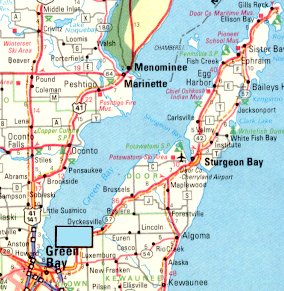The Great Peshtigo Fire
Today, the other great fire. The University of Houston's College of Engineering presents this series about the machines that make our civilization run, and the people whose ingenuity created them.
After I did a program about the great Chicago fire of 1871, a listener wrote. He asked why I hadn't mentioned the other, far worse, fire on that same October evening. So I shall:
The summer of 1871 had been one of driest on record. Chicago's wooden buildings were bone-dry tinder, but so too were the forests of northern Wisconsin and Michigan. That's why, at the same time Chicago went up in flames, the north woods did so as well.
The Chicago fire broke out at 9:00 PM, October 8, 1871, in Mrs. O'Leary's barn while she slept in her adjacent house. (How it was started, we don't know.) At the same time, citizens of Peshtigo, Wisconsin, were anxiously watching a copper-colored night sky northwest of town. All day, smoke and stillness had hung over Peshtigo. Now fire was bearing down upon it faster than anyone realized.
 Peshtigo was a young, burgeoning logging center with well over two thousand people in it. It lay near the west shore of Green Bay, next to Michigan's Upper Peninsula. The citizens had been fighting nearby forest and grass fires, and they seemed to be winning. But not until nine o-clock did they realize that a gale-driven fire of epic size was bearing down on them. When the firestorm struck, it did so with appalling speed. People could only run for the Peshtigo River. Some died of asphyxiation. Others ignited like Roman candles as they ran. Eyewitness accounts tell of children flashing into flame, as their mothers tried to hurry them into the water. One man went mad when he found that the burning wife he'd dragged to river was a stranger.
Peshtigo was a young, burgeoning logging center with well over two thousand people in it. It lay near the west shore of Green Bay, next to Michigan's Upper Peninsula. The citizens had been fighting nearby forest and grass fires, and they seemed to be winning. But not until nine o-clock did they realize that a gale-driven fire of epic size was bearing down on them. When the firestorm struck, it did so with appalling speed. People could only run for the Peshtigo River. Some died of asphyxiation. Others ignited like Roman candles as they ran. Eyewitness accounts tell of children flashing into flame, as their mothers tried to hurry them into the water. One man went mad when he found that the burning wife he'd dragged to river was a stranger.
The death toll in Peshtigo was eight hundred, but the fire touched many other towns in the area. The total was nearer twelve hundred. All told, it was five times worse than the Chicago Fire.
So I went back to old microfilms of the New York Times. Starting on October ninth, the day after the fire, and continuing for two weeks, Chicago was front-page news. The paper counted the dead and homeless. It reported property losses. It described relief efforts.
A few articles mention forest fires in Wisconsin and Michigan. One report says a hundred and fifty people lost their lives in the larger port of Green Bay. One article mentions more fires in Windsor, Canada. But it's only a sidebar against the theater of the Chicago fire, and legends about Mrs. O'Leary and her cow.
I suppose Peshtigo was kin to Ruanda or Biafra - too far from the public's mind, too far out in the wilderness of our new country. The importance of Chicago in 1871 can't be minimized - a rail center, a marketplace, a gateway to the West. That Fire interrupted the flow of 19th century America. Of course Chicago was on everyone's mind. But the far worse slaughter took place to the north, outside our national line of sight.
I'm John Lienhard, at the University of Houston, where we're interested in the way inventive minds work.
(Theme music)
Sources for this episode include New York Times articles for the two weeks following Oct. 8, 1871. See also: http://www.library.wisc.edu/etext/WIReader/WER2002-0.html
I am grateful to Paul Brownell of Houston, TX, for suggesting the topic.